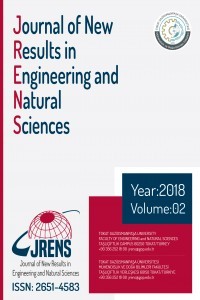Haptik-Teleoperasyon Sistemleri için PID ve SMC Kontrol Yöntemlerinin Tasarımı ve Bilgisayar Simülasyonu
Haptik-Teleoperasyon Sistemleri için PID ve SMC Kontrol Yöntemlerinin Tasarımı ve Bilgisayar Simülasyonu
Haptik-Teleoperasyon sistemleri, insan-robot etkileşiminde kullanılan sistemlerden biridir. Bu sistemlerin temel hedefi iki yönlü kesintisiz etkileşimdir. Bu hedef ancak sorunsuz çalışan iki yönlü kontrol ile mümkündür. Bu çalışmada sistemin kendinden veya çevreden kaynaklanacak tüm belirsizliklerin üstesinden gelmesi için PID ve Kayan Kipli Kontrol(Sliding Mode Control-SMC) yöntemleri tasarlanmış ve simülasyonu gerçekleştirilmiştir. Öncelikle sistemin hareket denklemleri elde edilmiştir. SMC yönteminde kullanılan signum işaret fonksiyonu çatırmada probleminde neden olduğu bilindiğinden çatırdama probleminin de giderilmesi için saturasyon fonksiyonu önerilmiş ve uygulanmıştır. Sonuç olarak haptik-teleoperasyon sistemleri için iki yönlü kontrol benzetim ortamında gerçekleştirilmiş, sonuçlar grafikler ve tablolar halinde verilmiştir. Performans kriterleri (RMSE ve MAE) kullanılarak sonuçlar karşılaştırılmış ve irdelenmiştir.
___
- [1] Zahedi, E., Khosravian, F., Wang, W., Armand, M., Dargahi, J., Zadeh, M. (2019). Toward Skill Transfer via Learning-Based Guidance in Human-Robot Interaction: An Application to Orthopaedic Surgical Drilling Skill. Journal of Intelligent & Robotic Systems, 1-12. 2.
- [2] Abut, T., Soygüder, S. (2018). Interface Design and Performance Analysis for a Haptic Robot. Muş Alparslan University Journal of Science, 6(2), 553-560.
- [3] Yang, G., Lv, H., Zhang, Z., Yang, L., Deng, J., You, S., ... Yang, H. (2020). Keep Healthcare Workers Safe: Application of Teleoperated Robot in Isolation Ward for COVID-19 Prevention and Control. Chinese Journal of Mechanical Engineering, 33(1), 1-4.
- [4] Bhaskar, S., Bradley, S., Sakhamuri, S., Moguilner, S., Chattu, V. K., Pandya, S., ... Banach, M. (2020). Full Title: Designing futuristic telemedicine using artificial intelligence and robotics in the COVID-19 era Short Title: AI and Robotics in COVID-19.
- [5] Moreau, R., Pham, M. T., Tavakoli, M., Le, M. Q., Redarce, T. (2012). Sliding-mode bilateral teleoperation control design for master–slave pneumatic servo systems. Control Engineering Practice, 20(6), 584-597.
- [6] Liu, X.,Tavakoli, M. (2011). Adaptive inverse dynamics four-channel control of uncertain nonlinear teleoperation systems. Advanced Robotics, 25(13-14), 1729-1750.
- [7] Hashtrudi-Zaad, K., Salcudean, S. E. (1996). Adaptive transparent impedance reflecting teleoperation. In Proceedings of IEEE International Conference on Robotics and Automation Vol. 2, pp. 1369-1374. IEEE.
- [8] Lee, H. K., Chung, M. J. (1998). Adaptive controller of a master–slave system for transparent teleoperation. Journal of Robotic systems, 15(8), 465-475.
- [9] Liu, X., Tavakoli, M. (2012). Adaptive control of teleoperation systems with linearly and nonlinearly parameterized dynamic uncertainties. Journal of dynamic systems, measurement, and control, 134(2).
- [10] Li, Y., Yin, Y., Zhang, D. (2018). Adaptive task-space synchronization control of bilateral teleoperation systems with uncertain parameters and communication delays. IEEE Access, 6, 5740-5748.
- [11] Xu, H., Fan, Y., Li, Q., Wang, F., Yan, J. (2019). Prediction-Based Adaptive Sliding Mode Control for Remotely Piloted System with Time Delay and Parameter Uncertainty. IEEE Access, 7, 86205-86216.
- [12] Abut, T., Soyguder, S. (2017). Real-time control of bilateral teleoperation system with adaptive computed torque method. Industrial Robot: An International Journal. Vol. 44 No. 3, pp. 299-311.
- [13] Liu, Y. J., Tong, S., Chen, C. P. (2012). Adaptive fuzzy control via observer design for uncertain nonlinear systems with unmodeled dynamics. IEEE Transactions on Fuzzy Systems, 21(2), 275-288.
- [14] Yang, Y., Hua, C., Guan, X. (2013). Adaptive fuzzy finite-time coordination control for networked nonlinear bilateral teleoperation system. IEEE Transactions on Fuzzy Systems, 22(3), 631-641.
- [15] Ziegler, J. G., Nichols, N. B. (1942). Optimum settings for automatic controllers. trans. ASME, 64(11).
- [16] Abut, T., Soyguder, S. (2019). Real-time control and application with self-tuning PID-type fuzzy adaptive controller of an inverted pendulum, Industrial Robot: the international journal of robotics research and application, Vol. 46 Issue: 1, pp.159-170,
- [17] Utkin, V. (1977). Variable structure systems with sliding modes. IEEE Transactions on Automatic control, 22(2), 212-222.
- [18] Abut, T., Soyguder, S. (2019). Sliding Mode Control of the Haptic-Teleoperation System Based on a Real and Virtual Robot. In 2019 International Artificial Intelligence and Data Processing Symposium (IDAP) (pp. 1-7). IEEE.
- [19] Zhao, L., Zhang, H., Yang, Y., Yang, H. (2017). Integral sliding mode control of a bilateral teleoperation system based on extended state observers. International Journal of Control, Automation and Systems, 15(5), 2118-2125
- [20]Tang, J., Huang, F., Chen, Z., Wang, T., Gu, J., Zhu, S. (2019). Disturbance-observer-based sliding mode control design for nonlinear bilateral teleoperation system with four-channel architecture. IEEE Access, 7, 72672-72683.
- Yayın Aralığı: Yılda 2 Sayı
- Başlangıç: 2013
- Yayıncı: Tokat Gaziosmanpaşa Üniversitesi
